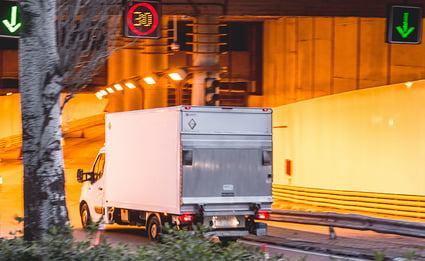How a VRS Solution Can Save Your Supply Chain
Keith LaBotz - September 15, 2022

A Vehicle Routing and Scheduling (VRS) solution may save your supply chain, so it's worth understanding what this software can do for your company.
Supply chains rapidly evolve with digitization, and supply chain management tools must also progress to remain effective. Like Mother Nature, survival of the fittest favors situational awareness, speed, and agility. These qualities will become increasingly critical, particularly for any company that manages a transportation operation.
Transportation providers and corporate fleets will face increased demands for quicker response times, lower operating costs, and more stringent delivery requirements. Digitalization will create an agility gap favoring the agile, and customer expectations will grow. Look to Amazon to understand the minimum expectations for a good customer experience.
Before a shipping operation can provide a good customer experience, it must fulfill numerous delivery requirements. Most TMS solutions can only partially address these requirements:
-
Goods transported profitably, sustainably, safely, and meet stakeholder expectations.
-
Shipments comply with customers' unique business demands, government regulations, and material handling requirements.
-
Vehicles and drivers are matched to multiple constraints to meet the previous requirements.
Creating a delivery plan to meet these requirements is only the first step. Transportation is dynamic, so plans must be too. In other words, the process used to manage a transportation fleet must be agile, updating delivery plans as conditions change.
An effective Vehicle Routing and Scheduling (VRS) solution can quickly resolve these complex challenges. This is the tool every transportation operation needs to survive and thrive in a digital supply chain, and this article explains how your company can use it.
What is Vehicle Routing and Scheduling (VRS) Solution?
A VRS solution automatically automates delivery plans for a fleet. As the name implies, this process automates two aspects of transportation planning: routing and scheduling. A few basic capabilities to look for:
- Comprehensively analyzes delivery requirements and constraints to create an optimized schedule.
- Dynamically routes vehicles by continuously monitoring changes enroute such as traffic conditions, last-minute customer requests, and other unexpected events.
What is Vehicle Scheduling?
Scheduling plans vehicle stops around pickup and delivery windows. In short, this involves determining how many employees and vehicles are needed to make these stops at the appropriate time and assigning orders to specific vehicles. The result is a delivery schedule for each vehicle in a fleet.
What is Vehicle Routing?
Vehicle routing, or route planning, is the process of mapping out the optimal route for each driver to complete scheduled stops. A good VRS solution considers all delivery requirements, operational constraints, greenhouse gas emissions, and dynamic variables like traffic conditions. The illustration below shows how a VRS routing algorithm transforms orders into routes.
A VRS Solution Should Produce a Dynamic Plan
A VRS solution should produce a dynamic delivery plan that updates as conditions change. Scheduling and routing work together to increase a company’s bottom line, allowing a delivery operation to scale up or down. Supply chain volatility has made this even more critical. Companies using the flexis VRS solution typically experience gains:
- 60% reduction in planning labor
- 20% savings in transportation costs
- 15% shrinkage in carbon footprint
For example, a company delivered 100 orders with ten drivers making ten daily stops. After implementing VRS software, optimization of schedules and routes reduced the drivers to eight.
A VRS Solution Should Support Strategic Planning
VRS software should also support strategic planning, such as whether to expand delivery operations. A good VRS solution is not just a productivity solution, but it should also be an analysis tool.
For example, the flexis VRS solution supports a “what-if” analysis to assess the impact of expanding transportation coverage and the vehicles used.
Live and test data can be run in numerous scenarios to determine costs, equipment needs, and emissions. Adding and removing EVs, diesel, and gas-powered trucks allows for assessing the impact on cost and carbon emissions. The analysis can reveal the optimal combination of vehicle types for fleet operations and service boundaries.
Another analysis can compare the impact of utilizing third-party transportation providers with in-house transportation. Cost comparisons with alternative modes and carriers reveal the least costly carrier selection.
VRS is No Longer Optional
A VRS solution is no longer optional for transport operators. Consider that there was a time when personal computers and spreadsheets were viewed as non-essential for managing delivery schedules and routes. The same was true when Google Routing came along. Do you think any transportation manager or dispatcher would dismiss these tools today?
Yes. Those who are ditching spreadsheets and Google Routing for an AI-enabled VRS solution.
Conclusion
Transportation operations need situational awareness, speed, and agility to survive and thrive. An effective VRS solution is the answer for supply chains, and flexis AG can provide it.
INTERESTED IN MORE INFORMATION?
LATEST POSTS
- Understand Circular Economy in The Manufacturing Industry
- How Can Industry 4.0 IT Integration Be Achieved Smoothly?
- The Significance of Order Sequencing in Discrete Manufacturing
- How to improve your Supply Chain Management: The Power of Control Towers
- Optimizing Human Resource Scheduling in Manufacturing: A Technological Approach



